new posts in all blogs
Viewing: Blog Posts Tagged with: Jennifer Thermes, Most Recent at Top [Help]
Results 1 - 23 of 23
How to use this Page
You are viewing the most recent posts tagged with the words: Jennifer Thermes in the JacketFlap blog reader. What is a tag? Think of a tag as a keyword or category label. Tags can both help you find posts on JacketFlap.com as well as provide an easy way for you to "remember" and classify posts for later recall. Try adding a tag yourself by clicking "Add a tag" below a post's header. Scroll down through the list of Recent Posts in the left column and click on a post title that sounds interesting. You can view all posts from a specific blog by clicking the Blog name in the right column, or you can click a 'More Posts from this Blog' link in any individual post.
By: C. C. Gevry,
on 10/26/2014
Blog:
The Children's and Teens' Book Connection
(
Login to Add to MyJacketFlap)
JacketFlap tags:
book reviews,
nonfiction,
Laura Ingalls Wilder,
Biographies,
Jennifer Thermes,
Middle Grade books,
books for young readers,
Little House books,
The Children's and Teens Book Connection,
children's books,
Yona Zeldis McDonough,
Little Author in the Big Woods,
Add a tag
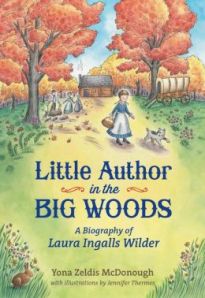 “Once upon a time, sixty years ago, a little girl lived in the Big Woods of Wisconsin, in a little gray house made of logs.” This sentence opens Little House in the Big Woods by Laura Ingalls Wilder, the first in a series of children’s books that gave middle grade readers a glimpse into the life of America’s pioneer families. And for some–like myself–this would be the start of a lifelong desire to learn more about the real life of Laura, her sisters Mary, Carrie, and Grace, and her parents Charles and Caroline Ingalls.
“Once upon a time, sixty years ago, a little girl lived in the Big Woods of Wisconsin, in a little gray house made of logs.” This sentence opens Little House in the Big Woods by Laura Ingalls Wilder, the first in a series of children’s books that gave middle grade readers a glimpse into the life of America’s pioneer families. And for some–like myself–this would be the start of a lifelong desire to learn more about the real life of Laura, her sisters Mary, Carrie, and Grace, and her parents Charles and Caroline Ingalls.
In a style similar to the Little House books, author Yona Zeldis McDonough has created a biography of Laura Ingalls Wilder aimed toward middle grade readers that not only helps point out the fact and the fiction behind Wilder’s classic children’s books, but also celebrates the independent mind of the Quiner and Ingalls women along the way.
McDonough’s book opens not with Wilder, but with a brief prologue discussing the life of Caroline Lake Quiner, who would one day become Caroline Ingalls. This sets the tone for the rest of this biography, as it highlights how Caroline’s mother, Charlotte, believed in higher education for girls; something Ma Ingalls also wanted for her daughters.
Told in chronological order, Little Author in the Big Woods follows Wilder’s life and the journeys she took not only with her family, but later with her husband Almanzo and daughter Rose. It talks about the hardships the Wilders faced as a young married couple and of their leaving De Smet, South Dakota to settle in Mansfield, Missouri. Readers learn about the building of the dream house on Rocky Ridge Farm and Wilder’s early career writing for the Missouri Ruralist, before moving on to the creation of the Little House series. McDonough ends with an epilogue that discusses the longevity of Wilder’s work and Michael Landon’s classic television show, Little House on the Prairie, which is based upon the books. Readers are also treated to quotes from Laura Ingalls Wilder, details on some of the games that Laura played, crafts, and recipes. Also included is a list of other writings by Wilder and a list with some of the other books about her.
While I have to admit I learned little new about Laura Ingalls Wilder as a result, I believe middle grade readers will enjoy getting to know more about her real life and the independent nature of the women in the Quiner, Ingalls, and Wilder families. With a similar writing style and design to the Little House series, readers will feel right at home with this book. Jennifer Thermes did an excellent job in capturing the essence of McDonough’s book and Wilder’s life with her beautiful illustrations. I’m thrilled to add Little Author in the Big Woods to my Laura Ingalls Wilder collection.
Rating: :) :) :) :) :)
Age Range: 8 – 12 years
Grade Level: 3 – 7
Series: Christy Ottaviano Books
Hardcover: 176 pages
Publisher: Henry Holt and Co. (BYR); First Edition edition (September 16, 2014)
Language: English
ISBN-10: 080509542X
ISBN-13: 978-0805095425
I received a copy of this book from the author. This review contains my honest opinions, which I have not been compensated for in any way.


click to enlarge
Last Tuesday I was a guest on Julie Danielson's blog, Seven Impossible Things Before Breakfast. Julie's questions are fun and thoughtful, and she takes great care to link to sites about the people and books referenced throughout the Q & A. Some of her links I'd never seen before.
The B Book was the first book that I read by myself. I loved it. But the premise of the book involves a play on words that troubled my six-year-old brain.
The little protagonist named Bumble is tired of being a bee and wants to be somebody else. He asks a big bee how to be something "Besides a Bee." The big bee then takes Bumble on a tour of all the wonderful things (Buttercups, Butterfly, Blackbird, etc.) that begin with the letter B, explaining with each stop that "Everything Best in the world Begins with a Big Bee." By the end of the tour Bumble is happy to be a bee. WHAT?
If I enjoy the illustration and the characters, can I ignore a big fat non sequitur? Almost.
Here's the cover and two interior images from my latest book, BEAR AND BIRD, which released this month. (Thanks for the "Bear theme" reminder, June!)
BEAR AND BIRD, written by James Skofield
Sleeping Bear Press, March 2014
www.jenniferthermes.com

By: Kathy Temean,
on 3/28/2012
Blog:
Writing and Illustrating
(
Login to Add to MyJacketFlap)
JacketFlap tags:
illustrating,
Jennifer Thermes,
Nicole Tadgell,
Illustrator Sites,
Kim Wood,
Bonnie Branson,
Marcy C. King,
Phyllis Mignard,
Vesper Stamper,
Add a tag
Here are the Illustrations sent in for the Month of March. Did it come in like a lion and go out like a lamb where you live?

Vesper Stamper works as an illustrator in a wide range of subjects from children’s books to album covers. Her work is inspired by her parallel career as a singer and musician in the band Ben + Vesper, on the Sounds Familyre label. Her book with fellow musician Stephen Roach (Songs of Water), Satchel Willoughby and the Realm of Lost Things (2010), is a top five finalist in the NAESP Book of the Year contest. Her e-book with LuAnn Kern, The Night the Tooth Fairy Didn’t Come (MeeGenius), was published earlier this year under the direction of Eve Adler. She lives in New Jersey with her husband, filmmaker Ben Stamper, and her two kids, who are experts in taking a backyard full of dirt and making it a world of wonders. http://www.vespersongs.com

Bonnie Branson is an Illustrator living in Newton MA. She is a graduate of the School of Visual Arts, and a member of the Society of Children’s Book Writers and Illustrators. Using Photoshop, Bonnie creates colorful, and whimsical illustrations for the children’s book market and focuses on cool stuff like HISTORY, COSTUMING, and NON-FICTION.
Website: http://www.artbonnie.com

Jennifer Thermes is a children’s book author and illustrator. Recent projects include illustrations for Maggie & Oliver, or A Bone of One’s Own, a middle grade novel by Valerie Hobbs. Jennifer’s art was also chosen for inclusion in this year’s SCBWI Bologna 2012 Illustrator’s Portfolio Display. Jennifer loves taking her pup for a walk on windy March days! Please see more work at: http://www.jenniferthermes.com .

Kim Wood is an aspiring children’s book author and illustrator with a background in toy design. Samples of her work are on view at her website, kimwoodstudio.com. Kim’s favorite spring time activities include tuning into the early morning chatter of the many birds outside her window and backyard wiffleball games with her three kids. http://kimwoodstudio.com/

Geeky Gecko illustration by Phyllis Mignard:
Creating illustrations and stories for picture books is an art form to me just like clay is to a sculptor or a piano to a musician. It appeals to both my practical and artistic nature. I draw to please myself and write because I can’t bear to part with my characters with their stories untold. http://www.phyllismignard.com/
 7 Comments on March Illustrations, last added: 3/29/2012
7 Comments on March Illustrations, last added: 3/29/2012
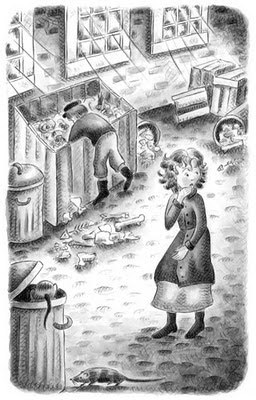
Here's a finished piece of art from a middle grade chapter book that I'm illustrating, for release next Fall. More details here!
This was created for a poster exhibit at an SCBWI conference a few years ago. (It's good to have friends!)www.jenniferthermes.comwww.art-words-life.blogspot.com
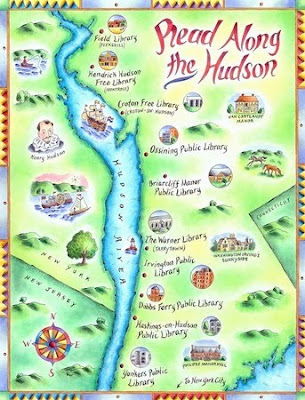
Over time I've posted a few links about posters and etsy print shops. My friend Jennifer Thermes and I now have a place to collect our print and poster finds, as well as showcase our work:
www.PrintsforChildren.blogspot.com
(The map above can be found at Jennifer's print shop)
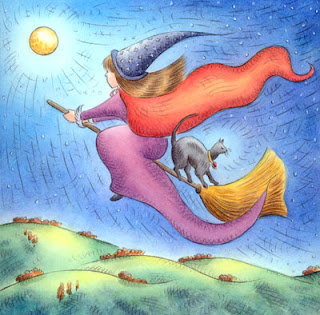
Well, maybe not too spooky. I'm a bit of a wimp about scary things...
Read the rest of this post

By:
Julie Fortenberry,
on 10/26/2008
Blog:
Children's Illustration
(
Login to Add to MyJacketFlap)
JacketFlap tags:
Jennifer Thermes,
Jody Sitts,
Steve Jenkins,
Christy Ottaviano,
Robert Lawson,
Barbara McClintock,
E. B. Lewis,
library,
SCBWI,
Mo Willems,
David Wiesner,
Grace Lin,
Add a tag
 Because I have amotivational syndrome (that’s a fancy way of saying that I’m lazy), I‘m going to link here to Stacy Mozer’s nice notes about a fantastic event that I attended yesterday. (Thank you, Stacy.)
Because I have amotivational syndrome (that’s a fancy way of saying that I’m lazy), I‘m going to link here to Stacy Mozer’s nice notes about a fantastic event that I attended yesterday. (Thank you, Stacy.)
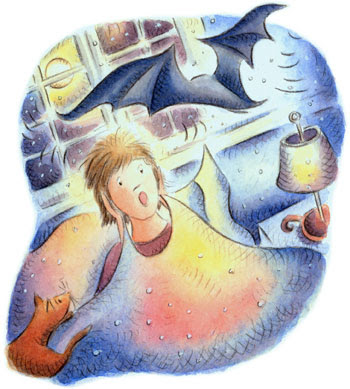
This piece was inspired by a real life event. I woke up early one Sunday morning to what I thought were the cats chasing a mouse. But it was no mouse. It was a bat, which flew directly into my face. And left a nifty scratch down my cheek. Spooky, for sure!
 Today's edition of Travel The World takes us to France. Originally published in 1996, Tibili: The Little Boy Who Didn't Want to Go To School was first published in America in 2002 by Kane/Miller. The author is Marie Leonard. The illustrator is Andree Prigent. Set in Africa, Tibili is the story of a little boy who didn't want to go to school.
Today's edition of Travel The World takes us to France. Originally published in 1996, Tibili: The Little Boy Who Didn't Want to Go To School was first published in America in 2002 by Kane/Miller. The author is Marie Leonard. The illustrator is Andree Prigent. Set in Africa, Tibili is the story of a little boy who didn't want to go to school.
Tibili is a happy little boy who laughs all the time, morning to night. Sometimes, if he is not too tired from playing all day, he even laughs himself to sleep.
But the laughter stops when his mother tells him that he'll be starting school the next year.
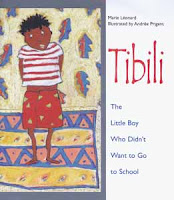
So he tries to talk to the animals and find ways out of going to school. He gets a lot of advice, but it is the advice of a spider named Crope that catches his attention. The spider tells him to find the big red stone and dig for the Box of Knowledge. If he can open this Box of Knowledge, he'll have his answer. He goes, he searchs, he finds. But alas, he can't find the directions on the Box of Knowledge because he doesn't know how to read. Instead of being discouraged, frustrated, or angry, Tibili hides the box and rushes home to his mother to ask WHEN school is starting.
The message the boy learns, it seems to me is that school has a purpose. Learning to read has a purpose. Reading DOES open the Box of Knowledge. Other books with this theme include Lauren Child's I Am Absolutely Too Small for School. (It's another 'international' title as a matter of fact. England.)

While it is natural for children to have doubts, worries, and fears about starting school for the first time, parents can reassure their children in many different ways that everything will be okay.
Viorst, Judith. 1995. Sad underwear and other complications. Illustrated by Richard Hull. New York: Atheneum Books For Young Readers. ISBN: 0-689-31929-0.
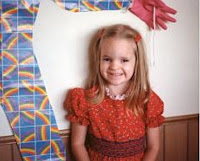
The First Day of School
Will they let me go when I need to go to the bathroom?
And what if I get lost lost on my way back to class?
And what if all of the other kids are a hundred, a thousand, a million times smarter than I am?
And what if we have a spelling test, or a reading test, or an…anything test, and I'm the only person who doesn't pass?
And what if my teacher decides that she doesn't like me?
And what if all of a sudden a tooth gets loose?
And what if I can't find my lunch, or I step on my lunch, or I (oops) drop my lunch down someplace like the toilet?
Will they just let me starve or will somebody lend me a sandwich? A cookie? A cracker? An apple?, Some juice?
And what if they say, "Do this," and I don't understand them?
And what if there's teams, and nobody picks me to play?
And what if I took off my sneakers, and also my socks, and also my jeans, and my sweatshirt and T-shirt,
And started the first day of school on the second day?
Extension
This poem lends itself well to extension activities. One book that comes to mind is Kevin Henkes' Wemberley Worried (2000). Wemberley is a very worried mouse. She like the child in the poem is very nervous about the first day of school. Another activity would be to have children write their own "what if" poem. (See also Shel Silverstein's "What If" (p. 90) in A Light In The Attic.)
Henkes, Kevin. 2000.
Wemberley worried New York: Greenwillow. ISBN: 0688170277.
Silverstein, Shel. 1981.
A light in the attic. New York: HarperCollins. ISBN: 006025673-7.
Poetry Friday roundup is at
Mentor Texts
Joe Fox: Don't you love New York in the fall? It makes me wanna buy school supplies. I would send you a bouquet of newly sharpened pencils if I knew your name and address. On the other hand, this not knowing has its charms. -- You've Got Mail (1998)

Hat tip to Robert at
Librarian in the Middle for finding this very interesting
article, "20 Things You Didn't Know About... Pencils."
All the facts are interesting. Three that caught my eye:
13 Pencils were among the basic equipment issued to Union soldiers during the Civil War.
14 The mechanical pencil was patented in 1822. The company founded by its British developers prospered until 1941, when the factory was bombed, presumably by pencil-hating Nazis.
16 More than half of all pencils come from China. In 2004, factories there turned out 10 billion pencils, enough to circle the earth more than 40 times.
Hmmm...recent recalls of Chinese products for lead paint make me wonder about all the teeth marks I've seen on pencils over the years. Oh dear.

Abdel-Fattah, Randa. 2007. Does My Head Look Big In This?
I have mixed feelings about Does My Head Look Big In This? My enthusiasm for the novel was not particularly consistent. (I liked the first third, I really liked the middle third, and I loved the last third.)
Amal Mohamed Nasrullah Abdel-Hakim is both your typical and untypical teen. As a Australian-Muslim-Palestinian, she feels she got "whacked with some seriously confusing identity hyphens" (5). To question one's identity is fairly typical--very standard--in YA literature. To deal with questions of race, prejudice, and faith is again fairly typical. But in most cases the race and faith in question is not Muslim (and Middle-Eastern). Hence why she is both typical and untypical. This makes the book good, but at times difficult to evaluate. Amal is a character that at the same time wants to be like everybody else, but she wants to be seen as special, unique, and one-of-a-kind. She wants to not stick-out in a crowd as being 'the Muslim' yet she is very proud of her culture, her religion, her faith. She wants to have it all. She doesn't want people to point, stare, and laugh. But she wants to be noticed. She wants to stand out. Again, I think that all teens--all people--go through a stage where they feel that the whole world is looking at them, staring at them, evaluating them, critiquing them, judging them, laughing at them, etc. I think every teen has the feeling that everyone is noticing them--watching for all the little flaws, waiting for them to make a mistake, etc. This sense of heightened awareness and the feeling that everything they do is more important that what it actually is. It is like going through life--your whole day, your whole week--like every moment could potentially be your most embarrassing moment ever. [Does that make any sense at all? What I'm trying to say is that they might be *imagining* the world is laughing at and judging them when really...no one is really paying that much attention.]
 Amal is ready to wear the hijab. Inspired by an episode of Friends, where Rachel braves the crowd to perform Copa Cabana after an embarrassing walk down the aisle, Amal has made her decision. Her first day of school--in what is essentially her junior year in high school--will be the first day she'll wear the hijab (and be covered) in front of her classmates at McCleans Preparatory School. What the book does not mention until halfway through--and what really makes a difference in appreciating the novel--is that this school year is 2002. It has only been a year since the 9/11 attacks in America. (That anniversary is covered in the novel.) So this is when tension--global tension--is at an all-time high. This attack is still fresh, the wounds still on the surface. There has been no healing. So prejudice is in many ways more out in the open than one would naturally expect.
Amal is ready to wear the hijab. Inspired by an episode of Friends, where Rachel braves the crowd to perform Copa Cabana after an embarrassing walk down the aisle, Amal has made her decision. Her first day of school--in what is essentially her junior year in high school--will be the first day she'll wear the hijab (and be covered) in front of her classmates at McCleans Preparatory School. What the book does not mention until halfway through--and what really makes a difference in appreciating the novel--is that this school year is 2002. It has only been a year since the 9/11 attacks in America. (That anniversary is covered in the novel.) So this is when tension--global tension--is at an all-time high. This attack is still fresh, the wounds still on the surface. There has been no healing. So prejudice is in many ways more out in the open than one would naturally expect.
Amal doesn't know quite what to expect from her classmates--boys and girls--she doesn't know if she'll be teased, laughed at, ridiculed, called-names, etc. For the most part, her close circle of friends accept her. They're proud of her. Embrace her with open arms. It takes the rest of the class a few more days--to get used to this new image--before they're minds are made up one way or the other. But let's just say her circle of friends expands through the year, it is not that they're not kids who give her a hard time--there is the typical bully who likes to slander and ridicule and mock all the lowly students she deems unworthy--but she finds a great support system.
But this book is about more than being a Muslim. It is about being a teen. It is about being not quite grown-up and having growing pains. Of wanting more freedom than parents are willing to allow. It is about friendships. Amal hangs out with her friends. All the time. Friends are what her world revolves around at times. And the book does a great job in fleshing out these characters and their families.
So the issues faced are in many, many ways that of a typical teen. She is a teen with problems and issues that most kids can relate to and understand. But she is unique too. It's all a balancing act between being 'just like everyone else--especially your friends' and 'being yourself.' Which again I think is fairly normal stuff. At times Amal seems mature, and at other times immature. Sometimes she seems wise, sometimes she seems foolish.
Anyway, what annoyed me at times was Amal's behavior. At times she was disrespectful to her parents and to authority figures in general. And the same things that annoy me about other teen heroines--such as Georgia Nicolson--annoy me about Amal. She can be at times a bit whiny in spots. She can be disrespectful and sarcastic in her narration. But overall I do like her. And I did enjoy this book.
Leaf, Munro. 1935. (reprinted 1963) The Boy Who Would Not Go To School: Robert Francis Weatherbee.
Today I am highlighting one of my childhood favorites. (I'm assuming it is the 1963 edition since that was the latest copyright year given. Although it could be early 70s.) The Boy Who Would Not Go To School is Munro Leaf's third picture book. It was published a year before his most-famous book The Story of Ferdinand. Written and illustrated by Leaf, it is a simple story of a boy named Robert Francis Weatherbee who absolutely refused to go to school no matter what his parents said. Here is how Leaf introduces us to our 'hero': This is Robert Francis Weatherbee, who was just like you and me when he was little--only his ears were bigger. His parents liked to imagine him growing up to be a fireman, a policeman, a sailor, or even the president of the United States. But young Robert didn't say a word. When the time came for him to go to school, his father gave him a book, his mother gave him a pencil, and the girl next door gave him an apple. They showed him where to go--the school was right up the road--but Robert Francis Weatherbee would not---WOULD NOT---go to school. And so the reader comes to the first parable:
One day Robert Francis Weatherbee went for a long walk all by himself way down a road that went through the woods. In and out, in and out he walked between the trees, until he was so tired and hungry he was ready to go home. But he learns that if you can't read the road signs, you can't know which way home is. (I liked how the sign posts read: "The Wrong Way" and "Home This Way"). Robert had to wait for his father to come find him. And he missed out on a tasty supper.
So the years pass, Robert grows bigger. (Although his ears are still rather large.) And one day Robert is sitting at home daydreaming about all the things he wants. Most of all he wants a pony with black and white spots. He feels that his uncle, who lives in the west, would send him a pony if he asked for it. But as he goes to get a pen and paper he realizes that it's hopeless. He can't write. He doesn't know how to ask his uncle for that pony after all.
The years really pass now. Robert is all grown up. And I mean ALL grown up. One day, Robert Francis Weatherbee was very hungry, and he asked his mother for a piece of pie. His mother told him to go out and get her ten apples, and she would make a whole pie all for him. So he went out to the orchard, where apples grow on the trees, to pick ten nice big red apples. But when he got there, he didn't get any because he didn't know how many apples are ten--because.....[drumroll please] Robert Francis Weatherbee could not count because he would NOT go to school. So he did not get even a little piece of pie this big.
But this time Robert has learned his lesson. He KNOWS that he made a big mistake all those years ago refusing to go to school. And he's finally ready to enter those classroom doors! So...Robert Francis Weatherbee WENT TO SCHOOL and he learned to read and to write and to count, and he had a good time. The last illustrations show a grown man sitting in a very tiny desk next to two children.
I think there were many things I liked about this book growing up. I liked the drawings. This stick-figure boy and his family. His big ears. The simple parables that were ever-so-obvious yet could cause giggles because we were smarter than Robert. And I liked the charming message that it's never too late to start. That learning is for a lifetime. That learning is for everyone. And I really liked how it was being hungry for an apple pie that made all the difference in the world. I think that is the part that stuck with me through the years.
Many books have been written since The Boy Who Would Not Go To School was published that are very similar. That highlight the benefits and joys of school days. But this one remains a favorite.
http://www.munroleaf.com/
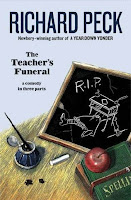
Peck, Richard. 2004. THE TEACHER'S FUNERAL: A COMEDY IN THREE PARTS. New York: Dial. ISBN 0803727364
With a winning opening line--"If you're teacher has to die, August isn't a bad time of year for it" --THE TEACHER'S FUNERAL is off to great start. Set in 1904, Russell Culver, fifteen, narrates this hilarious novel about his family, his community--and above all else--his experiences at Hominy Ridge, the local one room schoolhouse. Miss Myrt Arbuckle, the former teacher, died weeks before school was supposed to begin. And no one could have been happier than the Culver boys Russell and Lloyd. . . that is until they realized that their older sister Tansy would be taking her place as teacher! With Tansy in charge, Russell soon learned that he couldn't get away with anything. THE TEACHER'S FUNERAL has everything you need for a successful novel: great writing (particularly his descriptions and dialogue), great characterization (including both primary and secondary characters), and great pacing. Peck sure knows how to tell a story. THE TEACHER'S FUNERAL is one of the best books of the year. It is a book that begs to be read aloud over and over again. (There is an audio book available as well.)
http://www.richardpeck.smartwriters.com/
I know school has already started in some parts of the country. It starts here tomorrow.
Elaine Magliaro at Wild Rose Reader has assembled a truly wonderful offering of poetry for going back to school. She has a list of back to school poems and poetry books and suggestions for integrating poetry into the classroom. I love her suggestion of having students write a poem each week and then compiling that poetry in a booklet for each of them at the end of the year. What a meaningful memento of a school year that would be.
Helpful back-to-school advice
A year ago, Steve Blow of the Dallas Morning News authored some excellent advice for parents. Do read his whole column.
Here's the myth: Schools educate children.
Don't fall for it! Too many children have suffered already.
Let me explain. Of course schools can help educate a child. But just like a book or a pencil, a school is only a tool. And a tool can only do so much. A book can't open itself. A pencil has no words of its own. And schools alone can't educate.
Parents must be in charge of their children's education. To put it plainly: The success or failure of your child's education is up to you.
We spend a lot of time talking about "fixing" schools. The truth is that few are broken. The much bigger problem is parents who have forgotten their vital role. When that happens, schools struggle.
Teachers have a hard time discussing this. It sounds like they're making excuses. But it's true.
As a parent, you have the power to make a complete failure of the very best teacher or finest school. How? Easy. Just say bad things about the school to your child. Tell how unfair teachers were to you. Criticize a lot. Or simply take no interest at all. Trust me, your attitude will quickly be your child's attitude.
On the other hand, if you are excited about school, chances are your child will be, too. Make it clear how important education is to you. Set high goals. Volunteer at school if you can. At least introduce yourself to the teacher. Don't hesitate to make an appointment as soon as concerns arise. Working as a team is everything.
Reading Assignment


Finally, Rosemary Wells's
My Shining Star should be required reading for every single parental unit in the country. Over a year ago I
talked about this book after hearing Wells at a conference. The book lays out a path for raising a child who is ready for school. It seems so simple and so obvious but so many children will arrive at schools tomorrow, ill-equipped to learn.
Her preface explains her book's message.
All children bring to school what they learn at home.This book is about creating a home full of harmonyand the preparation of a successful child.You are your child's first teacher.
Students, teachers, librarians, and parents I hope this is a wonderful year for you all.
Good luck!
Leaf, Munro. 1935. (reprinted 1963) The Boy Who Would Not Go To School: Robert Francis Weatherbee.
Today I am highlighting one of my childhood favorites. (I'm assuming it is the 1963 edition since that was the latest copyright year given. Although it could be early 70s.) The Boy Who Would Not Go To School is Munro Leaf's third picture book. It was published a year before his most-famous book The Story of Ferdinand. Written and illustrated by Leaf, it is a simple story of a boy named Robert Francis Weatherbee who absolutely refused to go to school no matter what his parents said. Here is how Leaf introduces us to our 'hero': This is Robert Francis Weatherbee, who was just like you and me when he was little--only his ears were bigger. His parents liked to imagine him growing up to be a fireman, a policeman, a sailor, or even the president of the United States. But young Robert didn't say a word. When the time came for him to go to school, his father gave him a book, his mother gave him a pencil, and the girl next door gave him an apple. They showed him where to go--the school was right up the road--but Robert Francis Weatherbee would not---WOULD NOT---go to school. And so the reader comes to the first parable:
One day Robert Francis Weatherbee went for a long walk all by himself way down a road that went through the woods. In and out, in and out he walked between the trees, until he was so tired and hungry he was ready to go home. But he learns that if you can't read the road signs, you can't know which way home is. (I liked how the sign posts read: "The Wrong Way" and "Home This Way"). Robert had to wait for his father to come find him. And he missed out on a tasty supper.
So the years pass, Robert grows bigger. (Although his ears are still rather large.) And one day Robert is sitting at home daydreaming about all the things he wants. Most of all he wants a pony with black and white spots. He feels that his uncle, who lives in the west, would send him a pony if he asked for it. But as he goes to get a pen and paper he realizes that it's hopeless. He can't write. He doesn't know how to ask his uncle for that pony after all.
The years really pass now. Robert is all grown up. And I mean ALL grown up. One day, Robert Francis Weatherbee was very hungry, and he asked his mother for a piece of pie. His mother told him to go out and get her ten apples, and she would make a whole pie all for him. So he went out to the orchard, where apples grow on the trees, to pick ten nice big red apples. But when he got there, he didn't get any because he didn't know how many apples are ten--because.....[drumroll please] Robert Francis Weatherbee could not count because he would NOT go to school. So he did not get even a little piece of pie this big.
But this time Robert has learned his lesson. He KNOWS that he made a big mistake all those years ago refusing to go to school. And he's finally ready to enter those classroom doors! So...Robert Francis Weatherbee WENT TO SCHOOL and he learned to read and to write and to count, and he had a good time. The last illustrations show a grown man sitting in a very tiny desk next to two children.
I think there were many things I liked about this book growing up. I liked the drawings. This stick-figure boy and his family. His big ears. The simple parables that were ever-so-obvious yet could cause giggles because we were smarter than Robert. And I liked the charming message that it's never too late to start. That learning is for a lifetime. That learning is for everyone. And I really liked how it was being hungry for an apple pie that made all the difference in the world. I think that is the part that stuck with me through the years.
Many books have been written since The Boy Who Would Not Go To School was published that are very similar. That highlight the benefits and joys of school days. But this one remains a favorite.
http://www.munroleaf.com/
 “Once upon a time, sixty years ago, a little girl lived in the Big Woods of Wisconsin, in a little gray house made of logs.” This sentence opens Little House in the Big Woods by Laura Ingalls Wilder, the first in a series of children’s books that gave middle grade readers a glimpse into the life of America’s pioneer families. And for some–like myself–this would be the start of a lifelong desire to learn more about the real life of Laura, her sisters Mary, Carrie, and Grace, and her parents Charles and Caroline Ingalls.
“Once upon a time, sixty years ago, a little girl lived in the Big Woods of Wisconsin, in a little gray house made of logs.” This sentence opens Little House in the Big Woods by Laura Ingalls Wilder, the first in a series of children’s books that gave middle grade readers a glimpse into the life of America’s pioneer families. And for some–like myself–this would be the start of a lifelong desire to learn more about the real life of Laura, her sisters Mary, Carrie, and Grace, and her parents Charles and Caroline Ingalls.

































I did not know that Laura wrote for a newspaper. Thanks for sharing.